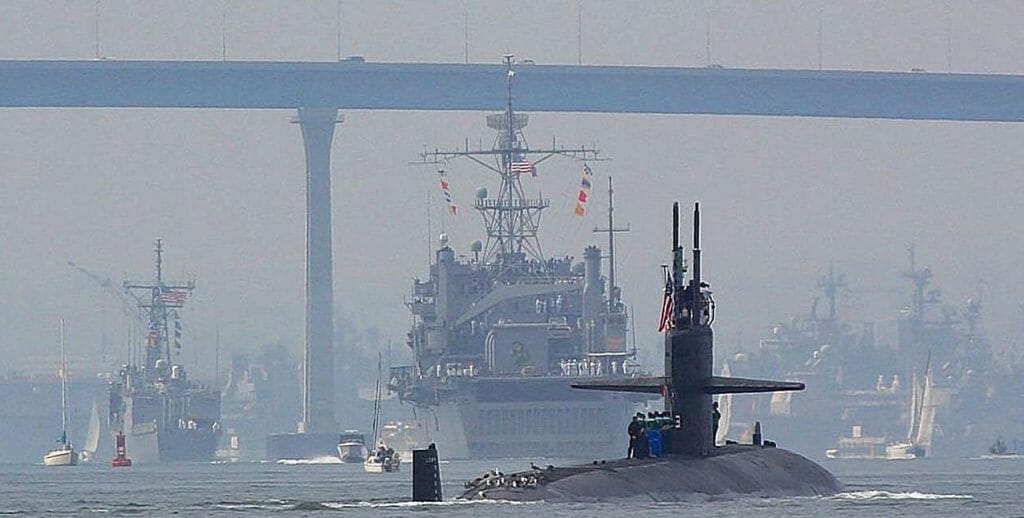Costly Research Unlikely to Pay Off for Nuclear Industry
Its last hope for competing with renewable energy is the creation of small modular reactors, but despite political support, the industry's future looks dim. Nuclear submarines powered by small modular reactors. (Jon Sullivan / Wikimedia Commons)
Nuclear submarines powered by small modular reactors. (Jon Sullivan / Wikimedia Commons)
On both sides of the Atlantic billions of dollars are being poured into developing small modular reactors. But it seems increasingly unlikely that they will ever be commercially viable.
The idea is to build dozens of the reactors (SMRs) in factories in kit form, to be assembled on site, thereby reducing their costs, a bit like the mass production of cars. The problem is finding a market big enough to justify the building of a factory to build nuclear power station kits.
For the last 60 years the trend has been to build ever-larger nuclear reactors, hoping that they would pump out so much power that their output would be cheaper per unit than power from smaller stations. However, the cost of large stations has escalated so much that without massive government subsidies they will never be built, because they are not commercially viable.
To get costs down, small factory-built reactors seemed the answer. It is not new technology, and efforts to introduce it are nothing new either, with UK hopes high just a few years ago. Small reactors have been built for decades for nuclear submarine propulsion and for ships like icebreakers, but for civilian use they have to produce electricity more cheaply than their renewable competitors, wind and solar power.
One of the problems for nuclear weapons states is that they need a workforce of highly skilled engineers and scientists, both to maintain their submarine fleets and constantly to update the nuclear warheads, which degrade over time. So maintaining a civil nuclear industry means there is always a large pool of people with the required training.
Although in the past the UK and US governments have both claimed there is no link between civil and military nuclear industries, it is clear that a skills shortage is now a problem.
It seems that both the industry and the two governments have believed SMRs would be able to solve the shortage and also provide electricity at competitive rates, benefitting from the mass production of components in controlled environments and assembling reactors much like flat-pack furniture.
This is now the official blueprint for success – even though there are no prototypes yet to prove the technology works reliably. But even before that happens, there are serious doubts about whether there is a market for these reactors.
Among the most advanced countries on SMR development are the US, the UK and Canada. Russia has already built SMRs and deployed one of them as a floating power station in the Arctic. But whether this is an economic way of producing power for Russia is not known.
Finding Investors
A number of companies in the UK and North America are developing SMRs, and prototypes are expected to be up and running as early as 2025. However, the next big step is getting investment in a factory to build them, which will mean getting enough advance orders to justify the cost.
A group of pro-nuclear US scientists, who believe that nuclear technology is vital to fight climate change, have concluded that there is not a large enough market to make SMRS work.
Their report, published in the Proceedings of the National Academy of Sciences, says that large reactors will be phased out on economic grounds, and that the market for SMRs is too small to be viable. On a market for the possible export of the hundreds of SMRs needed to reach viability, they say none large enough exists.
They conclude: “It should be a source of profound concern for all who care about climate change that, for entirely predictable and resolvable reasons, the United States appears set to virtually lose nuclear power, and thus a wedge of reliable and low-carbon energy, over the next few decades.”
Doubts Listed
In the UK, where the government in June poured £200 million ($263.8) into SMR development, a parliamentary briefing paper issued in July lists a whole raft of reasons why the technology may not find a market.
The paper’s authors doubt that a mass-produced reactor could be suitable for every site chosen; there might, for instance, be local conditions requiring extra safety features.
They also doubt that there is enough of a market for SMRs in the UK to justify building a factory to produce them, because of public opposition to nuclear power and the reactors’ proximity to population centres. And although the industry and the government believe an export market exists, the report suggests this is optimistic, partly because so many countries have already rejected nuclear power.
The paper says those countries still keen on buying the technology often have no experience of the nuclear industry. It suggests too that there may be international alarm about nuclear proliferation in some markets.
Your support matters…Independent journalism is under threat and overshadowed by heavily funded mainstream media.
You can help level the playing field. Become a member.
Your tax-deductible contribution keeps us digging beneath the headlines to give you thought-provoking, investigative reporting and analysis that unearths what's really happening- without compromise.
Give today to support our courageous, independent journalists.






You need to be a supporter to comment.
There are currently no responses to this article.
Be the first to respond.